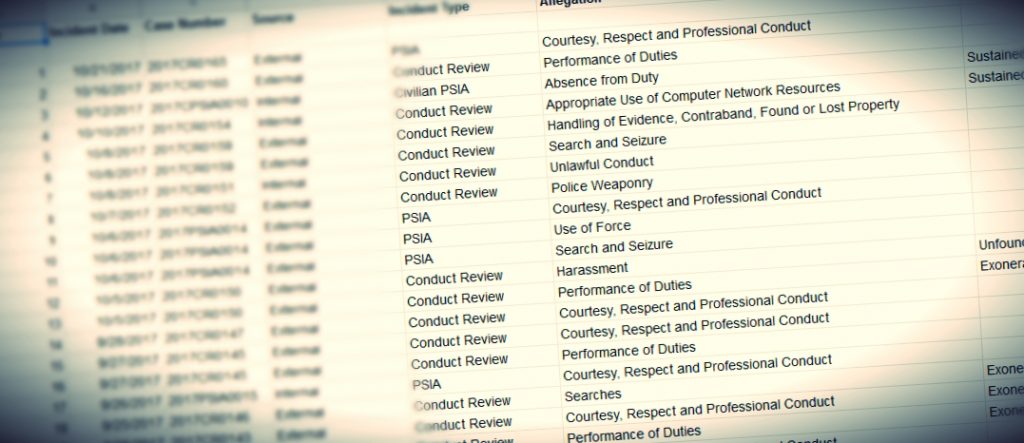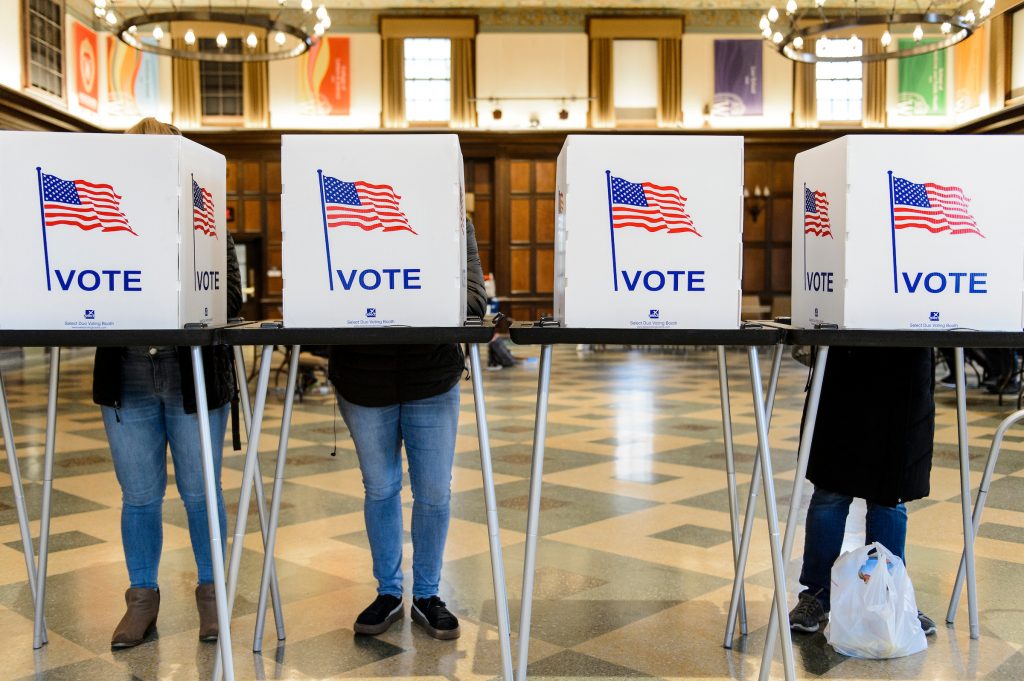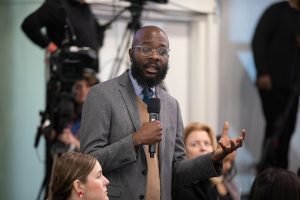 As news of yet another school shooting — this one in Santa Clarita, California — broke in mid-November, one key piece of information was decidedly absent from the headlines and initial internet search results: the name of the perpetrator.
As news of yet another school shooting — this one in Santa Clarita, California — broke in mid-November, one key piece of information was decidedly absent from the headlines and initial internet search results: the name of the perpetrator.
Though police had identified the gunman, many major outlets gave his name and description low billing in their reporting. It’s part of a reporting shift over the past few years that goes well beyond decisions about using names or images. In response to research suggesting that extensive coverage of these assailants may encourage others to follow suit, many outlets have chosen to devote less coverage to perpetrators and more to victims and to the laws and policies that have not prevented these tragedies.
Are the killings contagious?
Long before Julie Turkewitz knew she’d become a New York Times National Desk reporter — and long before she knew she’d cover more mass shootings than she can count — Turkewitz was a 13-year-old watching coverage of one of the nation’s earliest mass shootings: Columbine. She’s never forgotten what she saw.
“That was really the beginning of streaming news, 24-hour news,” she said of the 1999 tragedy. “Some of the images that I saw on TV … are seared in my brain still.”
Coverage of the nation’s early mass shootings focused heavily on perpetrators, a fact that has not escaped later perpetrators seeking such attention. So many people have admired the Columbine attackers that the phenomenon has a name — “the Columbine effect” — and admirers have a name too: “Columbiners.”
And it’s not just Columbine that inspires new attacks. The gunman who killed himself and nine others at Umpqua Community College in Roseburg, Oregon, in 2015 expressed in an online manifesto his allegiance with the Isla Vista gunman. It was the first mass shooting that Turkewitz would cover.
And the teenage gunman who killed 17 at a high school in Parkland, Florida, in 2017 said in a cell phone video, “I’m going to be the next school shooter of 2018 … It’s going to be a big event. When you see me on the news you’ll all know who I am.”
Researchers are working to determine whether mass shootings are essentially contagious, and the results are not yet clear. A 2015 study found that the likelihood of a mass shooting event was greater within two weeks of another mass shooting, but a 2017 study found no such link. Still, the authors of the 2017 study noted, “if outsized media coverage of mass killings is indeed increasing the frequency and lethality of subsequent attacks, the priority should be on altering coverage of these incidents so that no additional harm is done.”
“They’re seeking notoriety”
Caren Teves needs no convincing that the contagion effect is real. When her son Alex and 11 others were killed in 2012 in a movie theater in Aurora, Colorado, the coverage was perpetrator-focused as it had been 13 years before. “If coverage had changed immediately following Columbine,” Teves said, “I do believe my son would still be alive — and thousands of others.”
Since 2012, Teves and her husband, Tom, have made it their mission to convince media outlets to minimize their use of assailants’ names and photographs and thereby avoid glorifying assailants and their crimes. Their organization, No Notoriety, calls on news outlets to follow six guidelines, including naming perpetrators only once per story, not adding color to descriptions of perpetrators and not publishing perpetrators’ “self-serving” statements, photos or manifestos.
“The perpetrators are telling us themselves,” Teves said. “They’re seeking notoriety. So if we can eliminate notoriety, hopefully we can really cut down on rampage, mass shootings.”
The fact that journalists have already changed their practices to reduce the risk of suicide is proof that they can change their practices on this issue too, Teves said. “We’re not asking to reinvent anything. We’re just asking journalists to use the practices that are already in place.” In 2017, suicide-awareness group SAVE published recommendations designed to help reporters do just that.
Coverage shifts
While few outlets have publicly pledged to follow all of the No Notoriety guidelines, there’s no question that many outlets have changed their approach.
In a June Poynter article titled, “Not naming mass shooters (much) is now the norm,” Kelly McBride, chair of the Craig Newmark Center for Ethics and Leadership at The Poynter Institute, wrote, “For an industry that is often criticized for being slow to change, this development is remarkable.”
Al Tompkins, senior faculty for Broadcasting and Online for the Poynter Institute, has long made clear that he doesn’t believe outlets should stop naming perpetrators altogether. “There’s a difference between reporting and glorifying,” he said, differentiating between the nicknames news outlets gave criminals a century ago.
In fact, Tompkins said, reporting on the assailant’s behavior can provide an important service. “Virtually every mass shooter in the last 20 years has left behind a substantial trail of evidence that somebody could have stopped it,” Tompkins said. “You’ll never know everything we should and could know about the shooters — about what motivates them, who they are and so on — unless we take time to figure out who they are.”
But, given the possible risks, Tompkins said, minimizing the use of an assailant’s name and photo may be appropriate. (He offers his own recommendations here.)
The New York Times has no policy against naming the perpetrators of mass shootings, but Deputy National Desk Editor Julie Bloom said the outlet has taken steps to avoid feeding into the violence. It’s not rules but “more just a … sense of this is how to responsibly handle it.”
“I think we’re very careful,” Bloom said, noting that the Times makes deliberate choices about how often to name perpetrators and often avoid using their names in display copy. “We don’t want to be a platform … for giving attention to gunmen or attackers.”
Reporter Julie Turkewitz said this also means making choices about how to portray the gunman. Descriptions of an assailant’s outfit — for example, whether he wore white supremacist symbols or body armor — can become problematic, as they “sort of turn them into an image of an action figure,” whose image other perpetrators ritualize and copy. “That’s why it’s important to hit pause and say, ‘Is this description of their outfit adding something to the greater knowledge and reporting here?’” Turkewitz said.
Instead of just describing their outfits, Turkewitz said, reporters should ask deeper questions: “Where did they get that body armor, and why did nobody raise a flag? … If a perpetrator was wearing something with white supremacist symbols on it, what role did the political climate and white supremacy generally play?”
Meanwhile, many outlets have shifted coverage from assailants to the victims, survivors and their families, whose emotional and physical wounds will last lifetimes. Teves has noticed the shift. “When my son Alex was killed, if you think about the front page of the newspaper, all you saw was that red-haired individual,” Teves said. “If you look at the most recent shootings, if you look at the front page of the newspaper, what do you see? You see photos of the victims. So we know it’s changing.”
Growing frequency, technology prompt new approaches
Turkewitz attributes these new practices to the growing frequency of mass shootings. “It was hard to have that conversation … even in 2015 because these things didn’t seem to be happening quite as frequently,“ Turekwitz said. “As they have happened more and more, I think that there has been more of a reckoning and more of a thought to what is our involvement.”
But responsible reporting gets tougher as reporters are expected to report faster than ever, Turkewitz said, pointing to the 2015 San Bernardino shooting — which quickly became a talking point in the presidential campaigns — as the start of accelerated expectations.
Digital environments have also raised new ethical challenges for this reporting, Bloom said. Each outlet wants to appear at the top of the search results when someone Googles “El Paso attack,” for example, “but we also want to be careful that we’re not helping boost, say, the name of a gunman.”
Outlets could soon have a new set of principles to guide their reporting on these events. In an August Columbia Journalism Review article, Miles Kohrman, special projects editor at The Trace, and Katharine Reed, professor of practice at the Missouri School of Journalism, invited newsrooms to work with them as they draft guidelines on covering mass shootings. “Our work should not contribute to the country’s accelerating scourge of mass killings, driven by young men with firearms seeking fame and recognition,” the authors wrote.
But just making more ethical reporting choices isn’t enough, said Joy Mayer, an engagement strategist and director of Trusting News. Newsrooms also need to explain their choices to their audiences, as the Viriginian Pilot — a participant in the Trusting News project — did when it chose to name the man who killed 12 in Virginia Beach in May.
“The efforts of journalists to make thoughtful, respectful, consistent decisions are invisible to their audiences unless they shine a light on them,” Mayer said in an email. “The importance of transparency increases when the stakes are high. We simply must find ways to explain that we aim to be a public service, and we need to walk them through our decision-making.”
Not just about names — or even mass shootings
But ethical reporting on gun violence goes beyond decisions about naming or describing perpetrators. “This is the most low-hanging of all fruit,” Tompkins said, arguing that stopping shootings would require changing access to guns and ammunition. “But people don’t want to do that. What they want to do is say, ‘Oh, you know, if you just stop mentioning the shooter’s name, that’ll do it.’ No, it won’t … It’s just too simple. And all the easy stuff’s already been done.”
But writing stories about the laws and policies that have allowed these tragedies to occur comes with its own challenges. “We don’t know what policy failed if we don’t know what happened,” Turkewitz said. “We’ve got to understand the who, what, why, where and when, before we can step back and have the bigger conversation … I do think that’s why it’s kind of important to explore both wings.”
For The Trace, a nonprofit news outlet exclusively covering gun violence and gun policy, policy issues are the issues. While The Trace includes basic information about a shooting in stories about policy or victims, it doesn’t cover the events themselves as news. Many outlets want to “report out all the gory details of a particular incident and how it unfolded and what actually happened,” Kohrman said, “and I think our job is to kind of contextualize the shooting.”
In covering the Las Vegas shooting, for example, The Trace’s coverage focused on bumpstocks and “barely legal” accessories that can make legal guns more lethal. And in covering November’s Santa Clarita school shooting, The Trace asked how, in a state with some of the strictest gun laws in the country, a 16-year-old got a gun.
Getting serious about gun violence also means looking beyond single events, Tompkins said, noting that far more people die of gun violence in general than die in mass shootings, and yet more die from suicide than homicide. “We get so focused on the smallest numbers, while the largest numbers we don’t pay attention to,” Tompkins said.
Those largest numbers are the specialty of the reporters at The Trace. “I understand why news outlets focus so much on mass shootings because they are these huge international news events,” Kohrman said, though they represent only about 3% of all gun fatalities in the U.S. each year. “The media landscape coverage is skewed towards mass shootings. And that’s … not really an accurate representation of the issue.”
The Trace, meanwhile aims to explore “everyday gun violence … the steady drumbeat that happens every day.”
But, Kohrman acknowledges, The Trace is able to do that work in a way most outlets can’t. He said he talks to many editors who say they’d like to do more investigative reporting on guns but don’t have the resources. That’s why The Trace partners with other outlets, he said, to combine both gun expertise and local expertise.
“But, I mean, I think it’s something that everybody’s struggling with,” Kohrman said. “There’s no easy answer to it.”
CJE Fellow Natalie Yahr served as a freelance reporter for the New York Times national desk during the fall 2019 semester. Her work for the Times was independent of her reporting on this story.
The Center for Journalism Ethics encourages the highest standards in journalism ethics worldwide. We foster vigorous debate about ethical practices in journalism and provide a resource for producers, consumers and students of journalism. Sign up for our quarterly newsletter here.










